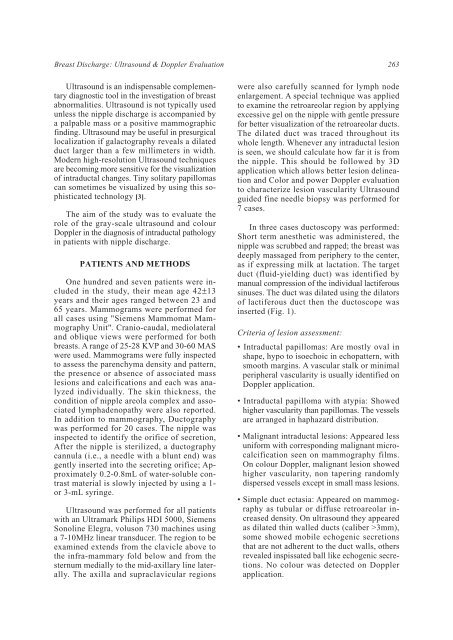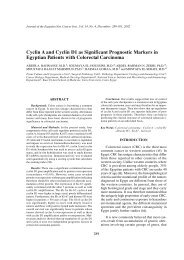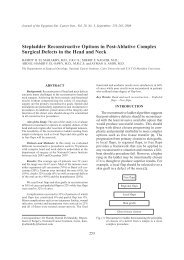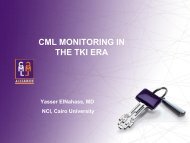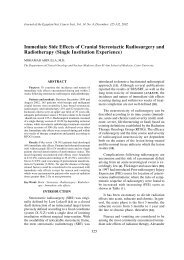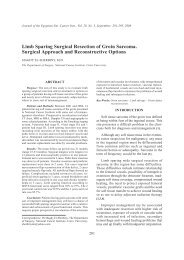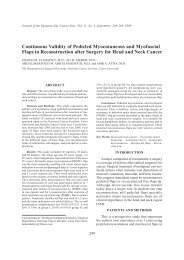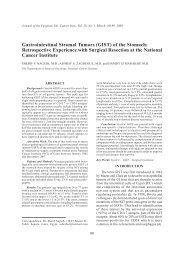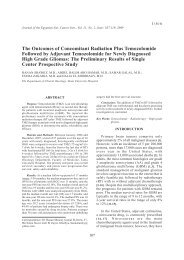Breast Discharge: Ultrasound and Doppler Evaluation - NCI
Breast Discharge: Ultrasound and Doppler Evaluation - NCI
Breast Discharge: Ultrasound and Doppler Evaluation - NCI
Create successful ePaper yourself
Turn your PDF publications into a flip-book with our unique Google optimized e-Paper software.
<strong>Breast</strong> <strong>Discharge</strong>: <strong>Ultrasound</strong> & <strong>Doppler</strong> <strong>Evaluation</strong><br />
<strong>Ultrasound</strong> is an indispensable complementary<br />
diagnostic tool in the investigation of breast<br />
abnormalities. <strong>Ultrasound</strong> is not typically used<br />
unless the nipple discharge is accompanied by<br />
a palpable mass or a positive mammographic<br />
finding. <strong>Ultrasound</strong> may be useful in presurgical<br />
localization if galactography reveals a dilated<br />
duct larger than a few millimeters in width.<br />
Modern high-resolution <strong>Ultrasound</strong> techniques<br />
are becoming more sensitive for the visualization<br />
of intraductal changes. Tiny solitary papillomas<br />
can sometimes be visualized by using this sophisticated<br />
technology [3].<br />
The aim of the study was to evaluate the<br />
role of the gray-scale ultrasound <strong>and</strong> colour<br />
<strong>Doppler</strong> in the diagnosis of intraductal pathology<br />
in patients with nipple discharge.<br />
PATIENTS AND METHODS<br />
One hundred <strong>and</strong> seven patients were included<br />
in the study, their mean age 42±13<br />
years <strong>and</strong> their ages ranged between 23 <strong>and</strong><br />
65 years. Mammograms were performed for<br />
all cases using "Siemens Mammomat Mammography<br />
Unit". Cranio-caudal, mediolateral<br />
<strong>and</strong> oblique views were performed for both<br />
breasts. A range of 25-28 KVP <strong>and</strong> 30-60 MAS<br />
were used. Mammograms were fully inspected<br />
to assess the parenchyma density <strong>and</strong> pattern,<br />
the presence or absence of associated mass<br />
lesions <strong>and</strong> calcifications <strong>and</strong> each was analyzed<br />
individually. The skin thickness, the<br />
condition of nipple areola complex <strong>and</strong> associated<br />
lymphadenopathy were also reported.<br />
In addition to mammography, Ductography<br />
was performed for 20 cases. The nipple was<br />
inspected to identify the orifice of secretion,<br />
After the nipple is sterilized, a ductography<br />
cannula (i.e., a needle with a blunt end) was<br />
gently inserted into the secreting orifice; Approximately<br />
0.2-0.8mL of water-soluble contrast<br />
material is slowly injected by using a 1-<br />
or 3-mL syringe.<br />
<strong>Ultrasound</strong> was performed for all patients<br />
with an Ultramark Philips HDI 5000, Siemens<br />
Sonoline Elegra, voluson 730 machines using<br />
a 7-10MHz linear transducer. The region to be<br />
examined extends from the clavicle above to<br />
the infra-mammary fold below <strong>and</strong> from the<br />
sternum medially to the mid-axillary line laterally.<br />
The axilla <strong>and</strong> supraclavicular regions<br />
263<br />
were also carefully scanned for lymph node<br />
enlargement. A special technique was applied<br />
to examine the retroareolar region by applying<br />
excessive gel on the nipple with gentle pressure<br />
for better visualization of the retroareolar ducts.<br />
The dilated duct was traced throughout its<br />
whole length. Whenever any intraductal lesion<br />
is seen, we should calculate how far it is from<br />
the nipple. This should be followed by 3D<br />
application which allows better lesion delineation<br />
<strong>and</strong> Color <strong>and</strong> power <strong>Doppler</strong> evaluation<br />
to characterize lesion vascularity <strong>Ultrasound</strong><br />
guided fine needle biopsy was performed for<br />
7 cases.<br />
In three cases ductoscopy was performed:<br />
Short term anesthetic was administered, the<br />
nipple was scrubbed <strong>and</strong> rapped; the breast was<br />
deeply massaged from periphery to the center,<br />
as if expressing milk at lactation. The target<br />
duct (fluid-yielding duct) was identified by<br />
manual compression of the individual lactiferous<br />
sinuses. The duct was dilated using the dilators<br />
of lactiferous duct then the ductoscope was<br />
inserted (Fig. 1).<br />
Criteria of lesion assessment:<br />
• Intraductal papillomas: Are mostly oval in<br />
shape, hypo to isoechoic in echopattern, with<br />
smooth margins. A vascular stalk or minimal<br />
peripheral vascularity is usually identified on<br />
<strong>Doppler</strong> application.<br />
• Intraductal papilloma with atypia: Showed<br />
higher vascularity than papillomas. The vessels<br />
are arranged in haphazard distribution.<br />
• Malignant intraductal lesions: Appeared less<br />
uniform with corresponding malignant microcalcification<br />
seen on mammography films.<br />
On colour <strong>Doppler</strong>, malignant lesion showed<br />
higher vascularity, non tapering r<strong>and</strong>omly<br />
dispersed vessels except in small mass lesions.<br />
• Simple duct ectasia: Appeared on mammography<br />
as tubular or diffuse retroareolar increased<br />
density. On ultrasound they appeared<br />
as dilated thin walled ducts (caliber >3mm),<br />
some showed mobile echogenic secretions<br />
that are not adherent to the duct walls, others<br />
revealed inspissated ball like echogenic secretions.<br />
No colour was detected on <strong>Doppler</strong><br />
application.


